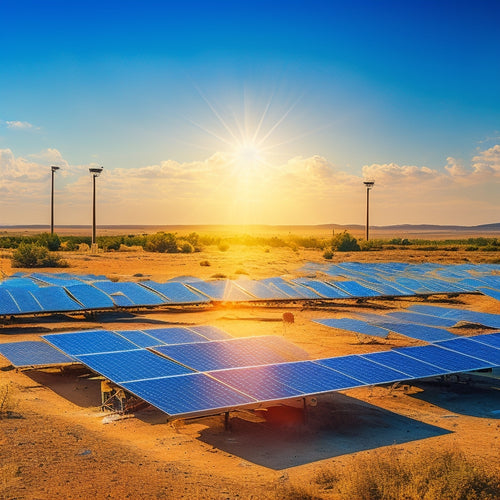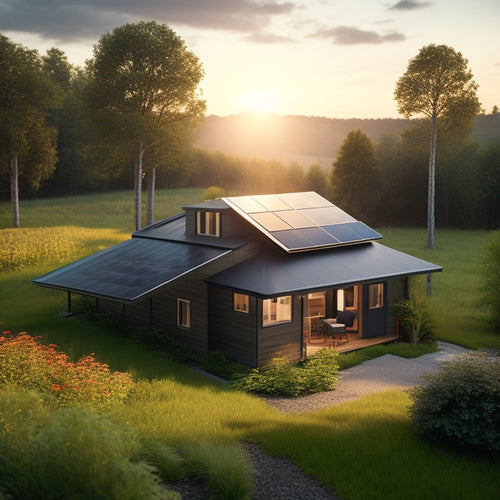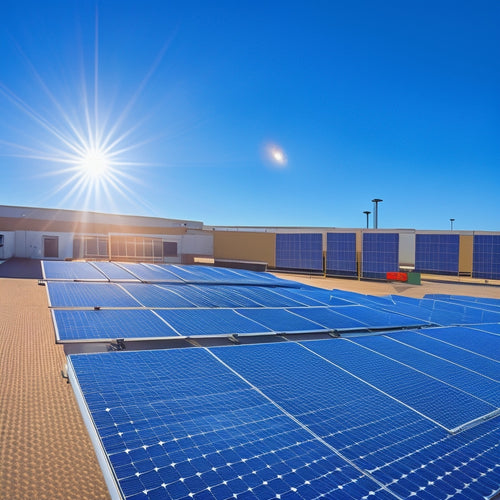
What Affects Energy Efficiency of Home Panels?
Share
When it comes to optimizing energy efficiency in your home solar panels, you'll want to focus on several key factors. For instance, minimizing shading through strategic panel placement and trimming trees can greatly enhance energy output. Selecting the right micro-inverter technology can also optimize energy production by ensuring each panel operates independently. Additionally, ensuring ideal panel configuration and roof size compatibility is essential, as it directly impacts overall energy production. By addressing these factors, you can maximize your system's energy efficiency and reap the benefits - and there's more to investigate when it comes to revealing the full potential of your home solar panels.
At a Glance
- Shading significantly reduces solar panel energy output, and even partial shading affects performance, emphasizing the need for mitigation strategies.
- Micro-inverters optimize energy production by ensuring independent panel performance, maximizing energy harvest, and reducing overall energy loss.
- Ideal panel configuration and roof size compatibility are crucial, as sizing solar panel systems requires matching wattage to available roof space.
- Space optimization strategies, such as maximizing roof space and considering system size, are essential for optimal sunlight exposure and energy production.
- Installation quality, warranty, and product assurance are vital for maintaining solar panel efficiency and protecting against defects and performance issues.
Higher Efficiency in Shading
When evaluating the energy efficiency of your home panels, you'll want to take into account the impact of shading on your system's performance.
To maximize energy production, it's crucial to have a reliable storage solution, such as a house solar battery, to store excess energy generated by your solar panels.
Specifically, you'll need to analyze the shading loss factors and how they affect the shaded area, as even partial shading can greatly reduce energy output.
Shading Loss Factors
Your solar panels' performance is significantly impacted by shading, which can lead to substantial energy losses. Shading loss factors are a critical consideration when evaluating the energy efficiency of your home panels.
There are several shading types that can affect your system's performance, including partial shading, where only part of the panel is shaded, and total shading, where the entire panel is shaded. The duration of shading also plays a significant role, as longer periods of shading will result in greater energy losses.
By integrating a battery storage system, you can store excess energy generated during the day to use during periods of shading, minimizing energy waste. Additionally, a battery storage system can provide a reliable backup power source during extended periods of shading or grid outages.
Understanding the different shading types and their durations is essential to optimizing your solar panel system's energy output. You need to identify areas where shading occurs and for how long to mitigate its impact.
For instance, if a tree branch casts a shadow on your panel for a few hours a day, you can trim the branch to minimize the shading duration. By addressing shading loss factors, you can maximize your energy yields and enjoy greater freedom from reliance on the grid.
Shaded Area Impact
By understanding the impact of shading on your solar panel system, you can take steps to mitigate energy losses. Shading can considerably reduce the energy output of your solar panels, but it's not all bad news.
With a reliable energy storage solution, such as a deep cycle power storage option off-grid energy solutions, you can store excess energy generated during peak sunlight hours and use it during periods of low energy output. By enhancing your solar panel installation, you can minimize the effects of shading and maximize energy efficiency.
The shaded area impact refers to the reduction in energy output caused by obstructions such as trees, buildings, or other structures. However, you can use shading techniques to your advantage.
For example, installing your solar panels at an ideal solar orientation can reduce the impact of shading. By angling your panels to receive the most direct sunlight, you can increase energy output even in shaded areas.
Additionally, using techniques such as bifacial panels or optimizing panel placement can help minimize energy losses due to shading.
Increased Property Value Boost
You'll likely see a significant increase in your property's resale value if you install energy-efficient home panels, thanks to the higher resale prices they command.
In fact, homes with energy-saving features like solar panels can sell for up to 17% more than similar homes without them.
Renewable energy systems not only reduce carbon footprint but also attract eco-conscious buyers.
Higher Resale Prices
Installing solar panels can greatly enhance a property's resale value, a benefit that savvy homeowners and investors are increasingly recognizing. As you consider installing solar panels, you'll be pleased to know that this investment can markedly elevate your property's market appeal.
According to recent energy market trends, home buyers are willing to pay a premium for energy-efficient homes. In fact, studies have shown that solar panels can increase your property's value by up to 17%. This increased value is largely driven by home buyer preferences, which prioritize energy savings and environmental sustainability.
As you weigh the benefits of solar panels, consider the long-term financial gains. With higher resale prices, you can recoup your initial investment and enjoy a noteworthy return on investment.
Additionally, with the growing demand for energy-efficient homes, you'll be well-positioned to capitalize on this trend. By installing solar panels, you're not only reducing your energy bills but also increasing your property's value, making it a more attractive option for potential buyers in the future.
Energy-Saving Features
Solar panels' ability to enhance property value is closely tied to their energy-saving features. When you invest in solar technology, you're not only reducing your carbon footprint but also increasing your home's appeal to potential buyers.
By incorporating energy management systems, you can optimize your energy consumption and reduce your reliance on the grid. Proper installation techniques and maintenance practices are essential to guarantee the longevity and efficiency of your solar panels.
Furthermore, government incentives and financial savings can offset the initial investment costs. The type of panel materials used also plays a significant role in energy efficiency.
Performance monitoring systems allow you to track your energy production and make adjustments as needed. As consumer awareness about environmental impact grows, having energy-efficient features in your home can be a major selling point.
Micro-inverters Boost Panel Output
You'll see a significant improvement in your solar panel's performance when you incorporate micro-inverters, which enable each panel to operate independently, allowing for peak energy harvesting and reducing energy loss due to panel mismatch, similar to what's achieved with grid tie systems.
This design flexibility is particularly useful in residential solar power systems where varying panel orientations and shading conditions are common.
This maximizes power harvesting by allowing each panel to produce its maximum potential, rather than being held back by underperforming panels in the array.
Increased Power Harvesting
Optimization of energy harvesting is an essential aspect of home panel systems, and micro-inverters play an important role in enhancing panel output. By converting DC power from each panel to AC power directly, micro-inverters guarantee that every panel operates at its maximum potential. This results in increased power harvesting, making the most of your solar technology investment.
| Micro-inverter Benefits | Description |
|---|---|
| Increased Energy Yield | Harvest more energy from your solar panels |
| Real-time Monitoring | Track performance and identify potential issues |
| Flexibility | Add or remove panels as needed without affecting the system |
| Maximum Power Point Tracking | Optimize energy production for each panel |
| Improved Safety | Reduce risk of electrical shock and fire hazards |
With micro-inverters, you can enjoy increased energy independence and reduced reliance on the grid. By maximizing your energy harvesting, you'll be able to store excess energy in your energy storage systems, providing you with a reliable backup during outages or peak hours.
Reduced Energy Loss
Panel-specific maximum power point tracking, courtesy of micro-inverters, guarantees that each panel operates at its peak potential, thereby minimizing energy loss. This means you'll get the most out of your solar panels, even when environmental factors like shading or debris affect individual panels.
Micro-inverters optimize energy production by ensuring each panel performs independently, rather than being limited by the weakest link. In a traditional string inverter system, energy loss occurs when one underperforming panel brings down the entire system.
Micro-inverters eliminate this issue, allowing you to maximize your energy harvest. Additionally, proper thermal insulation and sealing of your home can reduce air leakage, further minimizing energy loss.
Wattage Matches Roof Size
When sizing your solar panel system, you'll want to verify the wattage matches your roof's available space.
This ideal panel configuration is essential, as it directly impacts the system's overall energy production. By optimizing space, you'll be able to maximize your energy harvest while minimizing unnecessary equipment and installation costs.
For instance, conducting an energy audit can help identify areas of inefficiency, and considering factors like rooftop installation can further enhance your system's performance.
Ideal Panel Configuration
Across your roof, a precise arrangement of solar panels can release the full potential of your energy-harvesting system, and it all starts with ideal panel configuration. You want to maximize energy production while minimizing costs, and that's where panel orientation and installation angle come in. The ideal configuration guarantees that each panel receives maximum sunlight, generating the most electricity possible.
For ideal panel orientation, you'll want to take into account the direction your roof faces. In the northern hemisphere, a south-facing roof is ideal, as it receives the most direct sunlight throughout the day. If your roof doesn't face directly south, don't worry - a west- or east-facing roof can still produce a significant amount of energy.
When it comes to installation angle, you'll want to match it to your location's latitude. A steeper angle is best for higher latitudes, while a shallower angle is better for lower latitudes.
Space Optimization Matters
Maximizing your roof's available space is crucial to enhancing energy production, as undersizing or oversizing your solar panel system can lead to reduced efficiency and increased costs.
When it comes to space optimization, you'll want to confirm your panel placement is strategic and intentional. Consider your roof's orientation, as a south-facing roof receives the most sunlight throughout the day. This will help you determine the ideal placement for your panels.
You'll also want to assess your roof's size and shape to determine the best panel configuration. A system that's too small won't generate enough energy, while one that's too large will be a waste of resources.
By matching your system's wattage to your roof's size, you'll strike the perfect balance. A professional installer can help you assess your roof's unique conditions and design a system that enhances energy production while minimizing costs.
5-Year Warranty Guarantee
When you invest in home panels, you expect a reliable product that will perform efficiently for years to come.
A 25-year warranty guarantee provides you with assurance that the manufacturer stands behind their product, ensuring that any defects or issues will be addressed promptly.
With this guarantee, you can have confidence in your home panels' ability to generate clean energy while minimizing maintenance and repair costs.
Reliable Product Assurance
Your solar panel investment is safeguarded by a strong warranty guarantee, providing you with peace of mind and protection against manufacturing defects. A reliable product assurance is critical in confirming your solar panels operate at their best energy efficiency.
You should look for manufacturers with a proven reputation for producing durable products with high energy ratings. The quality of installation also plays a significant role in maintaining the performance of your solar panels. Proper maintenance practices and regular cleaning can help prevent energy losses.
Additionally, manufacturers who invest in technology advancements and provide excellent customer support are more likely to stand behind their products. When evaluating warranty terms, verify they comply with industry standards and provide adequate protection against environmental impact.
An extensive warranty guarantee should cover you against defects, performance, and labor for an extended period. By choosing a manufacturer with a strong product assurance, you can enjoy the freedom to generate clean energy while minimizing your reliance on the grid.
Frequently Asked Questions
Do Energy-Efficient Home Panels Require Special Maintenance?
When you install energy-efficient home panels, you'll want to contemplate special maintenance to guarantee peak performance. You're looking at regular cleaning, inspecting for damage, and addressing installation factors to maximize panel longevity, giving you the freedom to enjoy sustainable energy and cost savings.
Can Energy-Efficient Panels Be Installed on Old Roofs?
Ha! You think your old roof is a lost cause? Think again! You can install energy-efficient panels on it, but beware of installation challenges and ascertain your roof's suitability - it's all about the right assessment and prep, baby!
Are Energy-Efficient Home Panels Prone to Overheating?
You should know that energy-efficient home panels can be prone to overheating, which reduces their performance and lifespan. Effective thermal management is key to preventing overheating causes like high ambient temperatures, poor air circulation, and inadequate panel design.
How Do Energy-Efficient Panels Perform in Low-Light Conditions?
When you're evaluating energy-efficient panels, you'll find that advanced panel technology greatly improves low-light performance, allowing you to generate more power even on cloudy days, giving you the freedom to utilize renewable energy with confidence.
Can Energy-Efficient Panels Be Used With Solar Batteries?
As you steer through the renewable energy terrain, you're like a skilled sailor leveraging the winds of change. Yes, you can pair energy-efficient panels with solar batteries, releasing seamless solar battery compatibility and amplifying panel energy savings, giving you the freedom to chart your own course.
Explore More
As you consider home panels, remember that energy efficiency is essential. Did you know that a 1% increase in efficiency can translate to a 10% increase in revenue? That's significant! By understanding what affects energy efficiency, such as shading, property value, micro-inverters, and wattage, you can optimize your panel's performance. Don't settle for anything less than a 5-year warranty guarantee. With the right knowledge, you can maximize your energy output and reap the rewards.
Related Posts
-

What Happens Without a Charge Controller in Solar Panels
Without a charge controller in your solar panel system, you risk overheating batteries due to overcharging, which can...
-

Diy Off Grid Solar
By embracing DIY off-grid solar, you can break free from grid dependence, slashing your energy bills by up to 90% and...
-

Essential Solar Panel Mounts for Commercial Properties
When it comes to essential solar panel mounts for your commercial property, durability and wind resistance are key fa...


